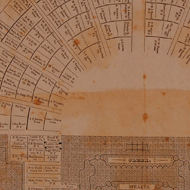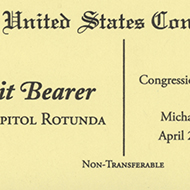Institution
For more than two centuries, the U.S. House of Representatives has carefully crafted rules and procedures to help it function as the legislative body that the Founders envisioned—“the People’s House.” Some practices are rooted in the U.S. Constitution; others are traditions adopted to meet the changing needs of the nation and the institution. Learn about the House’s role, powers, and development by exploring essays, Congress-by-Congress summaries, and profiles about the House’s unique culture.
Party Divisions of the House of Representatives (1789 to Present)
View a chart of House political party divisions since 1789.
House of Representatives Session Dates
View a chart with the dates the House has been in session, from 1789 to the present.
Joint Meetings, Joint Sessions & Inaugurations
Learn about the parliamentary difference between a Joint Meeting and a Joint Session of Congress. View a comprehensive historical chart containing these formal gatherings of Congress (including Presidential Inaugurations).
House Saturday & Sunday Legislative Days
View a chart with the dates the House has been in session from, 1789 to the present.
Presidential Vetoes
View a chart of the Presidents of the United States and the number of veto messages each issued.
Presidents, Vice Presidents & Coinciding Sessions of Congress
View a chart of the 44 U.S. Presidents and Vice President terms with their corresponding Congresses.
Funerals in the House Chamber
Under the current House Rule IV, the House Chamber may only be used for legislative functions, conference meetings, and caucus meetings unless the House agrees to take part in a ceremony. Earlier in House history, however, the chamber also served as a place to memorialize Representatives who died in office.
Desk Assignments
For more than a century, seat assignment in the U.S. House of Representatives was an important element in congressional life.
Total Members of the House & State Representation
This section includes the total number of Members who have served in Congress, as well as the numbers who have served each state.
Terms of Service for Members of the House of Representatives
These PDFs include Members of the House of Representatives in Congresses since the 114th (2015–2017).
Members With 40 Years or More House Service
Since Congress convened in 1789, 29 Members have served 40 years or longer in the House of Representatives.
Fathers/Deans of the House
In the modern U.S. House of Representatives the Member with the longest continuous service is known as the “Dean of the House.” The practice of recognizing this individual—initially, and for many years, called the “Father of the House”—dates to the early nineteenth century and has changed over time.
First-Term Members of the House of Representatives
The roles and expectations for first-term Members of the House of Representatives have changed over time. This table documents the number of Representatives serving their first term for each Congress, both pre-convening and post-convening “freshmen.”
Election Statistics, 1920 to Present
Since 1920, the Clerk of the House has collected and published the official vote counts for federal elections from the official sources among the various states and territories.
Vacancies & Successors, 1997 to Present
View a list of House vacancies and successors from the 105th through the 115th Congresses (1999–2019).
Majority Changes in the House of Representatives, 1856 to Present
Since the start of the modern party system in 1856, the House of Representatives has changed majority 18 times.
List of Individuals Impeached by the House of Representatives
The Constitution gives the House of Representatives “the sole Power of Impeachment” (Article I, Section 2) of federal officers and gives the Senate “the sole Power to try all Impeachments” (Article I, Section 3). This is a list of individuals impeached by the House.
List of Individuals Expelled, Censured, or Reprimanded in the U.S. House of Representatives
The Constitution grants the House broad power to discipline its Members for acts that range from criminal misconduct to violations of internal House Rules. Over the decades, several forms of discipline have evolved in the House.
Known House Cases Involving Qualifications for Membership
This section includes a historical list of cases in which the House of Representatives has examined the qualifications of Members-elect to serve in the House for either constitutional or personal reasons.
Funding Gaps and Shutdowns in the Federal Government
As required by the Constitution, all three branches of the federal government are funded through the appropriations process in the United States Congress. If regular appropriations bills is not signed into law before the start of the new fiscal year or a continuing resolution expires, parts of the federal government can experience a lapse in funding. This table lists each funding gap since 1977.
House Calendars, 1899–2019
Explore the chronological history of legislation within a Congress
Resumes of Congressional Activity, 1947–2019
Explore a comprehensive account of legislative business of the House.














